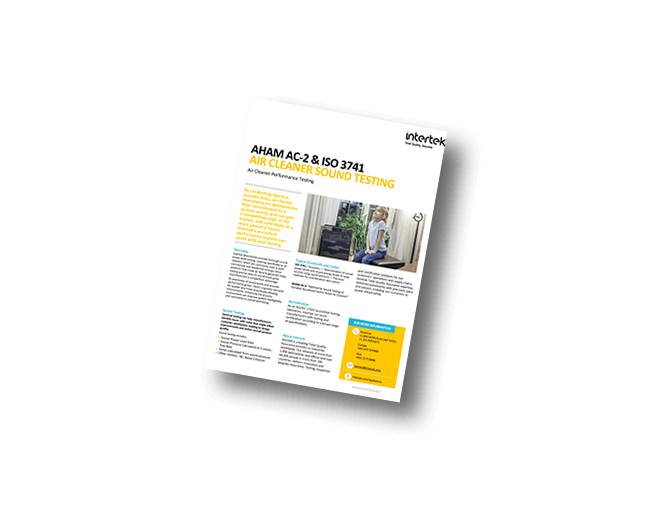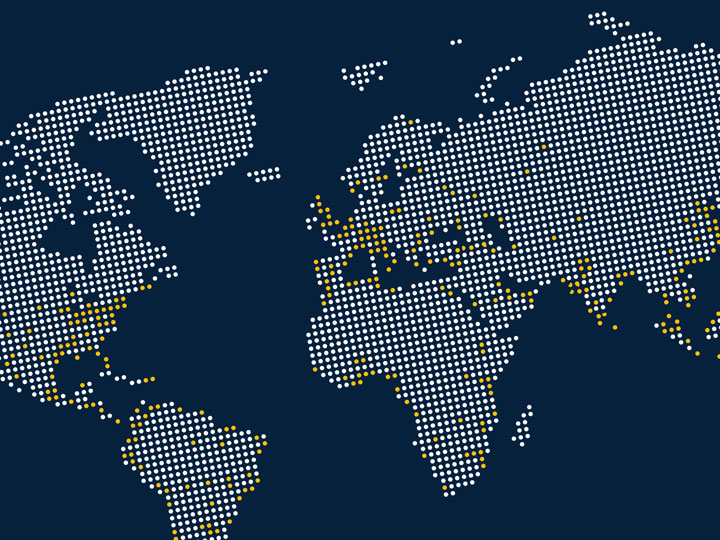From R&D solutions to market acceptance and claims verification, Intertek supports your air cleaner development every step of the way
As consumer demand for clean indoor air continues to grow, manufacturers of residential and commercial air cleaning devices must meet strict performance and safety standards. Intertek offers comprehensive air cleaner testing and certification services to help you bring safe, energy-efficient, and high-performing products to market quickly and confidently.
Whether you're launching a new air purifier or improving an existing product, Intertek’s industry-leading expertise supports compliance with global regulations.
Air Cleaner Testing Services
Ensure your air cleaner complies with essential electrical and mechanical safety requirements. We test to standards such as UL 507, UL 867, CSA C22.2 No. 187 and IEC 60335-2-65, helping you achieve certifications like cETLus Listed for North America and/or CB Certification or CE self-declaration for global market access. Learn more about our Appliance Safety Testing solutions.
We test to ensure your air cleaner meets strict ozone emission limits established by UL 867, UL 2998, California Air Resources Board (CARB), and other international requirements. Learn more about our Ozone Emissions Testing solutions.
We conduct AHAM AC-1 CADR testing to determine your product’s effectiveness in removing dust, tobacco smoke, and pollen. CADR ratings are a trusted performance indicator for consumers and retailers.
We assess your air cleaner’s ability to capture particulate matter such as PM2.5 and PM10 using HEPA or other filtration technologies, measuring reliable protection from airborne allergens and pollutants.
Volatile Organic Compounds (VOCs) can pose serious health risks. Our AHAM AC-4 chemical removal efficiency testing evaluates your air cleaner’s ability to remove common indoor air pollutants such as formaldehyde, toluene, and other hazardous VOCs.
Using specialized biological test chambers, Intertek evaluates your device's ability to reduce or eliminate airborne bacteria, viruses, mold spores, and other bioaerosols to AHAM AC-5, or other custom protocols. This includes antimicrobial surface resistance testing for product components. Learn more about our Microbiology Testing Services.
We evaluate Germicidal Air Cleaning systems in accordance with UL 8802 (Germicidal Systems) and UL 8803 (UV Germicidal Equipment) to verify safety, performance, and efficacy in reducing airborne pathogens. Testing includes verification of UV-C output, electrical and mechanical safety, microbial reduction effectiveness, and exposure safeguards to ensure compliance with applicable health and safety requirements.
Identify and quantify potentially harmful secondary pollutants emitted during device operation. We test for byproducts such as formaldehyde, acetaldehyde, ultrafine particles, NOx and ozone under controlled environmental conditions.
Intertek is a recognized certification body for ENERGY STAR® Certification. Our energy efficiency testing supports compliance with ENERGY STAR requirements, helping you reduce environmental impact and promote energy-saving benefits to eco-conscious consumers.
Evaluate your air cleaner’s noise performance to ensure user comfort and meet industry sound-level expectations. Intertek conducts sound power and sound pressure testing in accordance with AHAM AC-2 and ISO 3741, standards. Our precision acoustic chambers measure overall noise output and frequency distribution, helping you optimize product design, verify marketing claims, and ensure compliance with residential and commercial noise requirements.
Have a unique air cleaning technology or research need? Intertek can develop custom test protocols tailored to your specific product features, target pollutants, or operational modes. Our flexible approach supports innovation while ensuring performance and safety benchmarks are validated with sound scientific methodology.
Air Cleaner Safety and Performance Standards
Intertek tests a wide range of global and regional standards to ensure your air cleaning device meets regulatory and consumer expectations, including but not limited to:
- UL 507: Electric Fan Safety
Covers the electrical and mechanical safety of fans used in air filtering appliances - UL 867: Electrostatic Air Cleaner Safety
Includes requirements for electrical/mechanical safety, ozone emissions, and UV lamp systems - UL 2998: Zero Ozone Emissions Validation
Environmental claim validation for air cleaners that do not emit measurable ozone—key for CARB compliance. - UL 8802: Germicidal Systems
Covers safety and performance requirements for systems that use ultraviolet (UV), visible, or infrared light to inactivate microorganisms in air and on surfaces. - UL 8803: UV Germicidal Equipment
Defines construction, safety, and performance criteria for UV-C germicidal devices used for air and surface treatment. - AHAM AC-1: Clean Air Delivery Rate (CADR) for Portable Room Air Cleaners
Defines a repeatable method for measuring the effectiveness of portable room air cleaners in removing dust, pollen, and tobacco smoke from indoor air. - AHAM AC-3: Performance After Accelerated Particulate Loading
Measures air cleaner performance after exposure to simulated dust buildup, helping evaluate how filter loading impacts CADR over time. - AHAM AC-4: Chemical Gas Reduction Performance
Assesses the ability of a portable air cleaner to reduce concentrations of Volatile Organic Compounds (VOCs) in a controlled test chamber. - AHAM AC-5: Bioaerosol Reduction Testing
Evaluates how effectively an air cleaner reduces airborne biological contaminants like bacteria, viruses, and mold spores using an aerobiology test chamber. - AHAM AC-7: Energy Consumption of Room Air Cleaners
Defines test methods for measuring energy use in active and standby modes, supporting ENERGY STAR® qualification and product efficiency comparisons. - ASHRAE 241: Control of Infectious Aerosols
Sets requirements for air cleaning and ventilation to reduce airborne transmission of infectious aerosols. - CSA C22.2 No. 187: Canadian Electrostatic Cleaner Safety
Canadian standard for electrical and mechanical safety of electrostatic air cleaning devices. - IEC 60335-1 / IEC 60335-2-65: Global Electrical Safety Standards
International safety standards for electrical household and similar air-cleaning appliances. - ISO 16000 Series: Indoor Air Quality Testing
Defines standardized methods for evaluating indoor air pollutants, including VOCs and formaldehyde. - ISO 14698: Microbiological Air Quality Testing
Outlines procedures for biocontamination control, including sampling and evaluation of airborne microorganisms. - NRCC 54013 section 3.4: Canadian Method for Testing Portable Air Cleaners
Assesses the ability of a portable air cleaner to reduce concentrations of chemical gases (VOCs) in a controlled test chamber. - GB/T 18801 Annex C: National Standard of the People’s Republic of China for testing Air Cleaners
Determines a Clean Air Delivery Rate (CADR) for various chemical gasses in a controlled environment
Why Choose Intertek?
Intertek offers a global laboratory network with state-of-the-art air quality testing facilities across North America, Europe, and Asia, providing localized support with global reach. Our streamlined testing and certification processes help accelerate your time to market, while our Total Quality Assurance approach integrates safety, performance, energy efficiency, chemical, and microbiological testing under one roof. Call us to get your project started today!
Knowledge Center
SATELLITE™ Client Test Program for HVAC/R Products
Transform Your HVAC/R Supply Chain with SupplyTek
Flammable Refrigerants Testing: Refrigerant Detection Systems
ETL Certification Mark: HVAC/R Compliance to National Standards
HVAC Consulting Services with Intertek Assurance
UL 60335-2-40 Refrigerant Leak Detection Systems
Safety Certification Effective Dates for HVAC/R Equipment
Cybersecurity Certification for HVAC/R Equipment
Transitioning HVACR Equipment to UL/CSA 60335-2-40: Webinar | White Paper
EPA SNAP Rules and Certifying Appliances with Alternative Refrigerants
Guide to Flammable Refrigerant Mitigation
Scope of Intertek’s HVAC/R Capabilities | Poster
For more expert papers, recordings, and presentations, visit our HVACR Resources hub.


